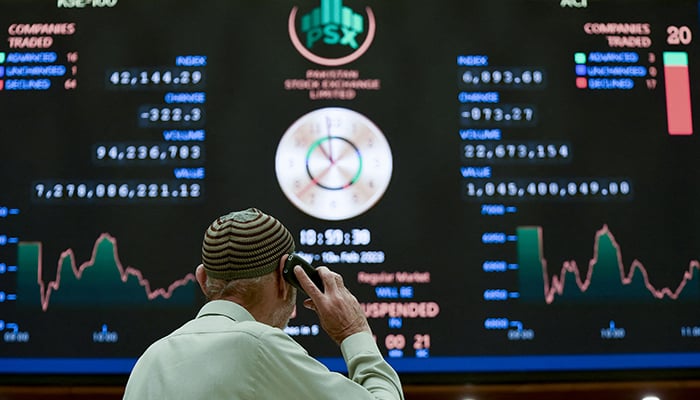
- The market is abuzz with speculation of interest rate cuts of up to 200 basis points.
- Improving macroeconomic indicators lead to a higher earnings season.
- Government efforts to privatize loss-making state-owned enterprises are boosting morale, the analyst says.
Stocks rose on Monday on bets that the central bank is preparing to extend its tight monetary stance at its Nov. 4 meeting. However, late profit taking pulled the market off an intraday high above 91,000 points – a first for the index.
The benchmark KSE-100 stock index of the Pakistan Stock Exchange (PSX) rose just 201.55 points or 0.22% to close at an all-time high of 90,195.51 after hitting an intraday peak of 91,054.83 points.
The market is abuzz with speculation about a major easing of the monetary policy stance on November 4, while profitable corporate results are also spurring buying in sectors such as automobiles, cement, banking, energy and power generation.
Top Line Securities said in a note that the session was characterized by volatility, as the index oscillated between the highest level at 91,055 points and the lowest level at 89,733 points, as investors took profits on a large scale in the overbought market.
Expectations of a possible interest rate cut and strong earnings fueled the bullish momentum, the brokerage said, adding that Pakistan’s request for a $1.4 billion loan to China also boosted sentiment.
Major contributors included Systems Limited, Colgate-Palmolive (Pakistan) Limited, State Oil Corporation of Pakistan Limited, Pakistan Oilfields Limited and Pakistan Petroleum Corporation Limited, which together added 341 points to the index.
Trading activity was intense, with trading value reaching 566 million shares worth 29 billion rupees. Fauji Foods Limited, with 53 million shares, emerged as the top stock in terms of volume.
Commenting on the rise, Tahir Abbas, Analyst at Arif Habib Limited (AHL), said: “The market is on the upswing, driven by a combination of improving macroeconomic indicators, exchange rate stability, and rising investor confidence following positive government policy initiatives.”
Abbas said that the recent easing of inflationary pressures and lower interest rates also contributed to increased liquidity, which encouraged investors to take new positions in stocks.
The rupee was mostly stable against the US dollar in the interbank market, while the current account recorded a surplus of $119 million in September.
said Sanaa Tawfiq, Head of Research at AHL Geo.tv The market has been on the rise mainly due to the overall season as well as improved liquidity in the country.
Speaking on the sidelines of the 2024 IMF-World Bank Annual Meetings in Washington, DC, State Bank of Pakistan Governor Jamil Ahmed expected the country’s foreign exchange reserves to reach $13 billion by the end of this fiscal year (FY25).
According to Ahmed, the strong rise in both exports and workers’ remittances is the main reason for the improvement in the current account balance.
“Our foreign reserves have risen to $11 billion,” Finance Minister Muhammad Aurangzeb, who leads the Pakistani delegation to the annual meetings of international financial institutions, said on Sunday.
He pointed out during a press conference after the conclusion of the American visit, “We have reduced dependence on foreign loans, and all banks are ready to cooperate with the government.”
It may be noted that as of October 11, 2024, the foreign exchange reserves of the State Bank of Pakistan have grown from a low of $3.1 billion at the end of January 2023 to $11 billion thanks to a decline in the current account and improved financial flows.
Ehsan Mehanti of Arif Habib said there was a very strong feedback that the Fed would take a hawkish stance on interest rates at its next meeting, while the government’s ongoing deliberations on privatization of loss-making state-owned enterprises (SOEs) also helped boost the momentum. Morale.
At its previous meeting, the state central bank’s Monetary Policy Committee (MPC) announced the largest interest rate cut since April 2020, lowering the key policy rate by 200 basis points to 17.5% due to moderating inflation and lower global oil prices. The central bank cut interest rates by 350 basis points in July and September 2024, resulting in a cumulative reduction of 450 basis points since June 2024.
If lowered, it would mark the fourth consecutive rate cut since the RBA began reversing interest rates in June 2024, signaling a marked improvement in the country’s macroeconomic outlook and a shift in the central bank’s monetary policy stance.
Speculations of a rate cut of up to 400 basis points by December are rife in the market, with analysts seeing room for monetary policy easing, which has also revived foreign investors’ interest in the country’s capital market.
Inflation fell to 6.9% year-on-year in September 2024, the lowest level since January 2021, down from 9.6% in August, driven by a high base effect, facilitating commodity and energy markets, and a stable currency, according to the PBO. Statistics (PBS).
